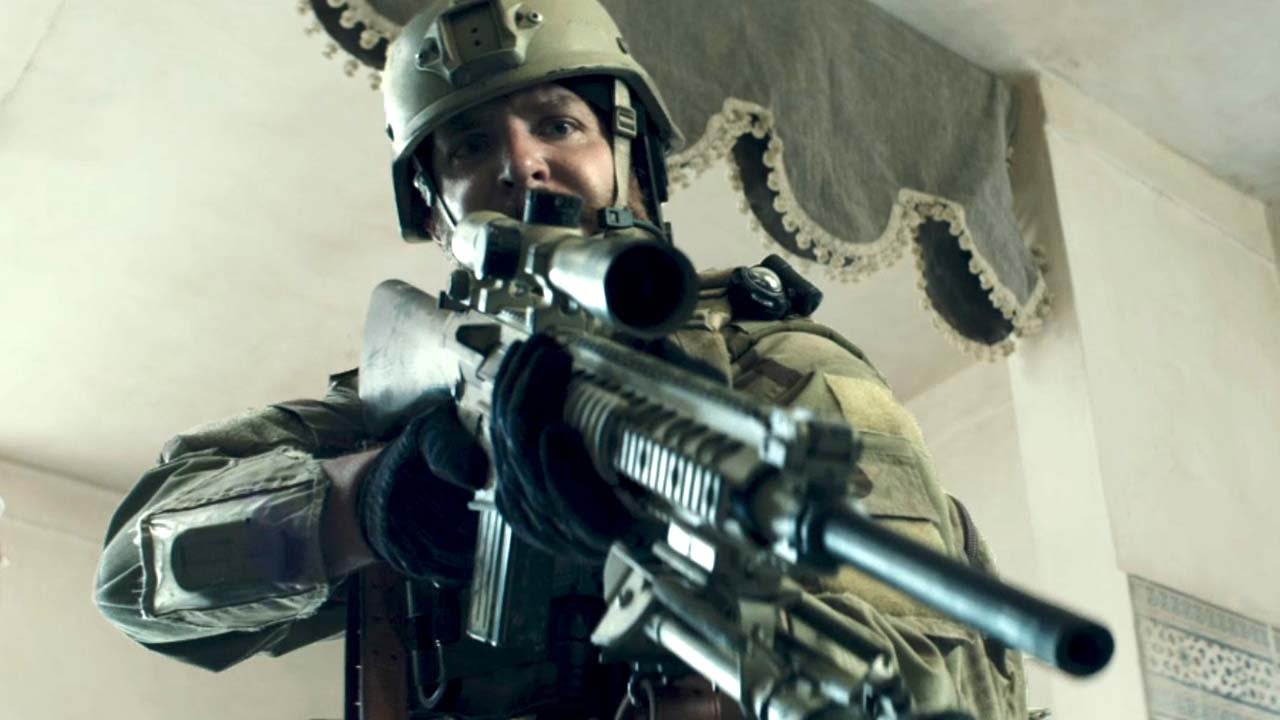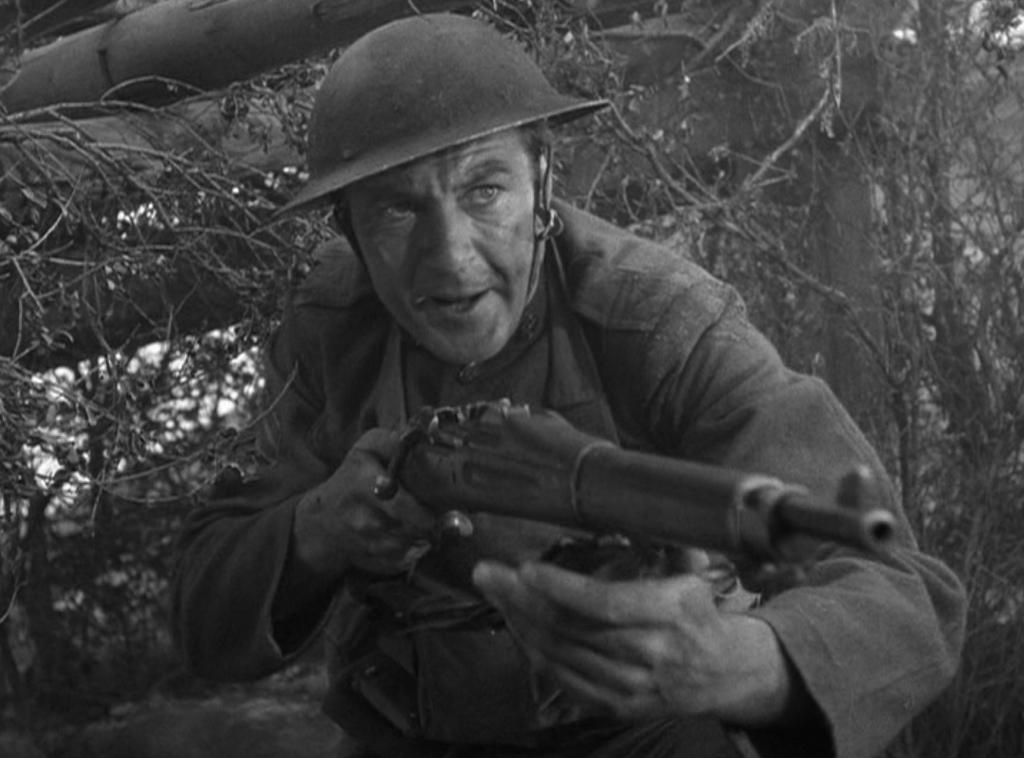A country boy, who is a fabulous natural shot, goes to war and neutralizes an unprecedented number of enemy combatants. Books are written. A respected Hollywood director makes the movie that will be the biggest hit of his career: it’s received with near-unanimous praise, an Oscar nomination for Best Picture, and no small amount of controversy.
The movie is Howard Hawks’s Sgt. York, starring Gary Cooper as the real-life World War I hero Alvin York, which opened five months before Pearl Harbor, and went on to be the most popular movie of 1941—“a phenomenon of staggering proportions,” according to Hawks’s biographer Todd McCarthy. The same can be said of Clint Eastwood’s American Sniper. A portrait of “the most lethal sniper in American military history,” Iraq War hero Chris Kyle, freely drawn from Kyle’s memoir, American Sniper is not just a movie but a movie-event. It has already surpassed Steven Spielberg’s Saving Private Ryan as the top-grossing war film in Hollywood history and, still climbing, may be the top-grossing movie of any kind of 2015.
American Sniper is a sleeper, which is to say no one in the movie industry expected it to perform so well at the box office. No less surprising, perhaps, is the film’s skill and conviction—the adroit shifts in time and space, epitomized by an early time-expanding flashback, or the moments of unexpected beauty, as in a sandstorm-shrouded firefight between Kyle’s unit and a group of Iraqi insurgents that occurs late in the film. An adventurous but wildly uneven filmmaker as well as a paradoxical personality, Eastwood has a propensity to play the fool (straight man to an orangutan in Every Which Way But Loose, lecturing an empty chair at the 2012 Republican Convention). But here, the octogenarian director is fully engaged with his material.
While American Sniper has drawn a large and diverse audience there is no consensus as to what the movie means. Rush Limbaugh hailed it as “an extension of the November elections” in which the Republicans captured the Senate, although the war in Iraq was hardly an issue. Jane Fonda saw it as a movie about the psychic cost of war and compared it to her 1978 film Coming Home, in which she embarked upon a therapeutic love affair with Jon Voight’s seriously wounded Vietnam veteran. The American-Arab Anti-Discrimination Committee has reported a spike in anti-Arab threats. A French journalist contacted me in early January to see if I thought the movie’s unexpected popularity was a response to the Charlie Hebdo massacre. (I told him that, on the contrary, the success struck me as symptomatic of American self-absorption.) Eastwood, who, not surprisingly, has described American Sniper as an anti-war movie, has acknowledged the influence of Sgt. York, which he saw as an eleven-year-old in the company of his father.
Sgt. York was criticized in Congress and elsewhere as pro-war and didn’t win the 1941 Oscar for Best Picture (the award, given in late February 1942, went to John Ford’s How Green Was My Valley). American Sniper, a far better movie, is unlikely to win either—no more than Ava DuVernay’s Selma, the film that, as a myth about a different kind of American heroism and a meditation on another aspect of the national past, has naturally been seen as American Sniper’s political antipode, celebrating non-violence from the inherently underdog perspective of a disenfranchised minority. Both movies are docudramas, a term first used to describe the televised historical fictions of the mid-1970s, and both have been criticized for their historical inaccuracies.
While these distortions are hardly without interest, holding films to rigorous standards of truth is itself highly unrealistic. With origins in photography, the motion picture medium encourages us to expect that, unlike plays or novels, films depicting historical episodes should be truthful. But even for documentaries, fictionalizing elements—including editing, camera placement, and imposed chronology—are almost inescapable. For feature films, the dramatization of actual events is itself subject to any combination of colorful performances, intriguing locations, exciting plot development, visual panache, political correctness, and topical interest. However much a part of the popular debate, historical veracity is mostly tangential to how a particular docudrama works as a movie.
Because DuVernay’s subject, Dr. Martin Luther King, Jr., is a world-historical figure, her first task as a movie director is to humanize him. This she does mainly through a cautious treatment of his extramarital sex life. At the same time, DuVernay wants to dramatize—and indeed insist upon—King’s heroic singularity. In particular, she wants to avoid any sense of a generic black and white buddy film like Lethal Weapon or The Defiant Ones or, most recently, White House Down. Hence the suggestion that King acted in large part on his own, and the presentation of the white leader Lyndon Johnson as more King’s adversary than his ally. But, most importantly, she wants to recast American history in a particular way—not unrelated to the still remarkable fact that Barack Obama, a racially-mixed child born without wealth or privilege, could assume the starring role in our national drama.
Advertisement
Far more crucial to evoking this exalted sense of progress is the need to dramatize the brute reality of institutional racism and the gathering force of a mass movement that transformed America. As befits the story of a larger-than-life figure of the civil rights movement, Selma is an uplifting tale of heroic leadership and history making—the movie triumphantly embodies what Sarah Palin, a stout defender of American Sniper, mockingly called “that hopey-changey thing.”
American Sniper promises neither hope nor change, but Eastwood, too, must humanize his hero, played by Bradley Cooper (no relation to Gary). Thus the interruption of the opening scene with a long flashback to Kyle’s Texas boyhood: as the movie begins, an American tank rolls through the rubble of Fallujah and Kyle, posted above to scan the street for threats, detects a small boy heading towards the Americans with a very large bomb. With the sniper’s finger on the trigger and the child in his cross-hairs, the film cuts away from Iraq to young Chris getting life lessons in church and from his father (both preacher and dad seem to be mimicking Eastwood cadences, not unlike the way Woody Allen’s characters sometimes pick up their director’s phrases). Kyle’s father is particularly emphatic in dividing the world into sheep, predatory wolves, and guardian sheepdogs—the role his son is destined to assume.
As a rodeo cowboy, Kyle is a quintessential Texan and no less a hell-raiser than Gary Cooper in the early part of Sgt. York. Kyle too is moved to enlist. Inspired by the 1998 embassy bombings in Tanzania and Kenya, he joins the SEALs. While on leave he meets the woman who will be his devoted, long-suffering wife (Sienna Miller). At home, watching 9/11 on TV, he resolves to go to war… in Iraq. Destiny or divine providence has delivered him to this moment in Fallujah, with his hand on the trigger and his gun pointed at the Iraqi boy with the bomb. Kyle has no choice but to kill the child and also, after she picks up the bomb, the unnatural woman who is apparently his mother.
Not surprisingly, Iraqi audiences have responded with outrage to this scene (an episode that was redacted from Kyle’s book). But Americans who recognize the sniper as protecting them, their surrogates, or their interests, are more or less compelled to endorse it. On the one hand, Kyle is portrayed as a relatively independent operator in the ongoing struggle between his comrade supermen and their sub-human Iraqi adversaries. (Call it the American Dream.) On the other, he carries the burden of our collective guilty conscience by fighting on our behalf.
Driven by an internal mandate to protect the flock, Kyle must return again and again to do battle with the wolves (until he himself dies). And, time zones notwithstanding, he also possesses an uncanny ability to telephone his wife back home amid even the most brutal battles. Disturbing in itself, this capacity to force his situation into her daily consciousness, serves to reproach the spectator: how little attention American society gave to the hellish experiences and bloody accomplishments of its designated defenders.
No doubt American Sniper would have been a richer, if less popular, movie had Eastwood not airbrushed his protagonist’s troubled psyche. (It might even have been The Searchers.) In his writings the real-life Kyle called Iraqis “despicably evil” and maintained that his only regret was that he didn’t kill more. Clearly, he is no Alvin York—a devout Christian and conscientious objector who was persuaded to go to war and afterward devoted himself to creating educational opportunities in rural Tennessee.
Yet for all its patriotic rhetoric, American Sniper is not a moral lesson but a tragedy. The causal link Eastwood establishes between the trauma of September 11 and the catastrophe of Iraq is less the dramatization of history than an illustration of historical paralysis—elaborating the implications of an endless, unwinnable war. The protagonist is seen to return again and again to the battlefield until, in a real life irony, he dies at the hands of an even more disturbed Iraq War veteran. (That the murder trial of Kyle’s killer is now set to begin has heightened the debate about American Sniper.)
American Sniper embodies a national repetition compulsion, what Freud defined as “the desire to return to an earlier state of things.” For the artist that state may be the memory of watching the unambiguously heroic Sgt. York in the reassuring company of his father. For some members of the audience, American Sniper may offer a similarly comforting sense of a guardian angel and a cathartic righteous anger. For others, the movie may serve to assuage contrition for a war that, twelve years after it was begun, has left Iraq, as well as many of our own returning combatants, shattered. But for many, I suspect, American Sniper may be weirdly liberating—gratifying a perhaps hitherto unsuspected desire to see their pessimism, hopeless and unchanging, projected on the screen.
Advertisement




